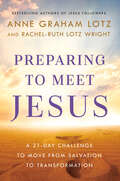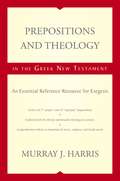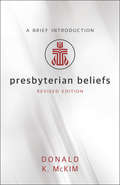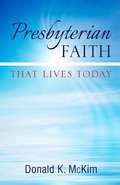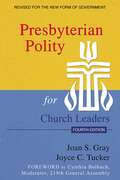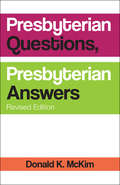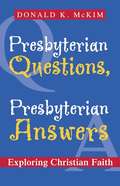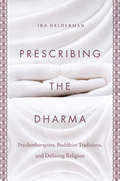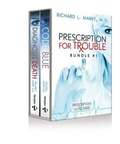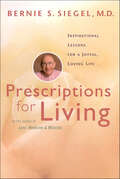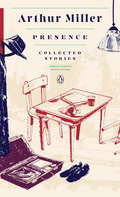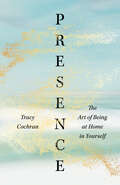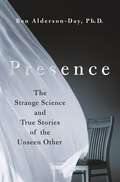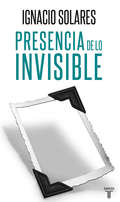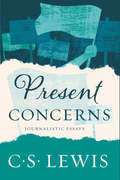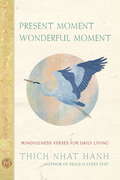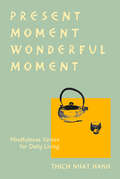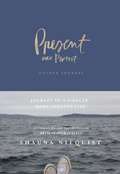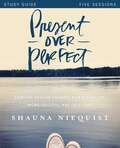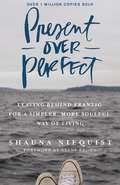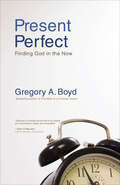- Table View
- List View
Preparing to Meet Jesus: A 21-Day Challenge to Move from Salvation to Transformation
by Anne Graham Lotz Rachel-Ruth Lotz WrightExperience the joy of knowing you are prepared for your first look into the eyes of Jesus. One day, every believer will experience the wonder of coming face-to-face with Jesus. Can you imagine how thrilling that encounter will be? This unique devotional from Anne Graham Lotz and her daughter Rachel-Ruth leads you on a transformational journey so that you can live fully prepared for the awesome moment of the &“first look.&” Drawing on the biblical story in which Abraham seeks a woman of character to marry his son Isaac, Preparing to Meet Jesus explores the characteristics God the Father looks for in a bride for His Son, Jesus. Each of these 21 daily reflections, challenges, and prayers reveals how you can pursue a life fully devoted to the One who loves you and gave Himself for you. Preparing ourselves for Jesus&’s imminent return is the greatest privilege and responsibility of our lives. Jesus is coming! Are you ready?
Prepositions and Theology in the Greek New Testament: An Essential Reference Resource for Exegesis
by Murray HarrisPrepositions are important in the exegesis of the Greek New Testament, but they are at the same time very slippery words because they can have so many nuances. While Prepositions and Theology in the Greek New Testament rejects the idea of a “theology of the prepositions,” it is a study of the numerous places in the Greek New Testament where prepositions contribute to the theological meaning of the text.Offered in the hope that it might encourage close study of the Greek text of the New Testament, its many features include the following:Coverage of all 17 “proper” and 42 “improper” prepositionsExplores both literary and broader theological contextsGreek font—not transliteration—used throughoutComprehensive indexes to hundreds of verses, subjects, and Greek wordsDiscussion of key repeated phrases that use a particular preposition
Presbyterian Beliefs: A Brief Introduction
by Donald K. McKimThis book is a clear introduction to the major beliefs of Presbyterians. Donald McKim describes in easy-to-understand language what Presbyterians believe about key Reformed theological topics. <P><P>The revised edition has been updated to include recent changes in the new Form of Government and the Confession of Belhar, among others. Ideal for personal and group study in churches, Presbyterian Beliefs includes ten unique case studies and questions for considering how to apply Presbyterian beliefs to church and daily life.
Presbyterian Faith That Lives Today
by Donald K. MckimIn this insightful book, Donald K. McKim explores the basic tenets of Presbyterian theology and doctrine, from their beginnings to their meaning for the church today. Throughout McKim emphasizes the how Presbyterian history can inform current and future challenges. Without prescribing solutions to contemporary challenges, McKim's six brief chapters provide the foundation for broadening and strengthening a Presbyterian faith the lives today. Each chapter ends with suggestions for further study.
Presbyterian Polity for Church Leaders
by Joan S. Gray Joyce C. TuckerThis detailed, comprehensive interpretation of the Presbyterian Book of Order is the most complete resource of its kind. Joan S. Gray and Joyce C. Tucker have revised this best-selling book to include the new standards from the new Form of Government in the Book of Order. It explains the system of Presbyterian government, from sessions to presbyteries to synods to the General Assembly itself.
Presbyterian Questions, Presbyterian Answers: Exploring Christian Faith
by Donald K. McKimPresbyterians often have questions about Presbyterian theology and beliefs that are basic to Christian faith itself. Featuring a unique question-and-answer format, Presbyterian Questions, Presbyterian Answers is an accessible and concise treatment that provides a sampling of these questions on important topics and brief but complete answers from a distinguished Presbyterian theologian. <P><P>Fully updated for the changes to the Presbyterian new Form of Government, this revised edition also includes updated entries and six new questions and answers. Arranged according to doctrinal topics, the book is ideal for individual and group study, church officer training, new member and confirmation classes, and all those who are interested in Presbyterian theology.
Presbyterian Questions, Presbyterian Answers: Exploring Christian Faith
by Donald K. MckimQuestions include: What is the purpose of the Bible? Why are Presbyterians associated with predestination? What is the purpose of life? Arranged according to doctrinal topics, the book is ideal for individual and group study, church officer training, new member and confirmation classes, and all those who are interested in Presbyterian theology.
Presbyterians and American Culture
by Bradley J. LongfieldThis book provides a history of Presbyterians in American culture from the early eighteenth to the late twentieth century. Longfield assesses both the theological and cultural development of American Presbyterianism, with particular focus on the mainline tradition that is expressed most prominently in the Presbyterian Church (U. S. A. ). He explores how Presbyterian churches--and individuals rooted in those churches--influenced and were influenced by the values, attitudes, perspectives, beliefs, and ideals assumed by Americans in the course of American history. The book will serve as an important introduction to Presbyterian history that will interest historians, students, and church leaders alike.
Prescribing the Dharma: Psychotherapists, Buddhist Traditions, and Defining Religion
by Ira HeldermanInterest in the psychotherapeutic capacity of Buddhist teachings and practices is widely evident in the popular imagination. News media routinely report on the neuropsychological study of Buddhist meditation and applications of mindfulness practices in settings including corporate offices, the U.S. military, and university health centers. However, as Ira Helderman shows, curious investigators have studied the psychological dimensions of Buddhist doctrine for well over a century, stretching back to William James and Carl Jung. These activities have shaped both the mental health field and Buddhist practice throughout the United States.This is the first comprehensive study of the surprisingly diverse ways that psychotherapists have related to Buddhist traditions. Through extensive fieldwork and in-depth interviews with clinicians, many of whom have been formative to the therapeutic use of Buddhist practices, Helderman gives voice to the psychotherapists themselves. He focuses on how they understand key categories such as religion and science. Some are invested in maintaining a hard border between religion and psychotherapy as a biomedical discipline. Others speak of a religious-secular binary that they mean to disrupt. Helderman finds that psychotherapists' approaches to Buddhist traditions are molded by how they define what is and is not religious, demonstrating how central these concepts are in contemporary American culture.
Prescription for Love
by Andrea BoeshaarDetermined never to have financial worries like her ministry-driven parents had when she was younger, Ravyn has her life goals set. With her new condo and a great job--the perfect stepping-stone in her nursing career--Ravyn is sure she'll never have to depend on anyone but herself. So why does Dr. Mark Monroe's reappearance in her life make her long for something more? Mark Monroe has goals, too. As soon as he's done with his residency, he plans to raise support and head overseas as a medical missionary. But before he goes, he has to figure out why his old friend Ravyn has resented him for so many years. Can Ravyn believe Mark isn't what she thought? And can they both give up their own ambitions for the plans God has perfectly prescribed for them?
Prescription for Mystery (Miracles and Mysteries of Mercy Hospital #2)
by Ruth Logan HerneWhile digging through dusty hospital archives, Anne Mabry discovers a box tucked away in the darkest recesses of the windowless room. The contents of the box compel Anne, Shirley, Evelyn, and Joy to join forces and find out whatever happened to the promising young ER doctor who went missing thirty years before--a young doctor whose family had long roots in Charleston society, roots that predated the Civil War. When Dr. Byron Wellington disappeared without a trace, no one knew what to think. Was he forced to leave without saying goodbye? Or was it something worse? Something even more sinister? As the ladies search out tidbits of information, they discover much more than they were looking for. In this lingering mystery of the past, the women realize that all is not what it seems on the surface and that, in the end, the truth does indeed set you free. Four talented women from very different walks of life witness the miracles happening around them at Mercy Hospital and soon become fast friends. Join Joy Atkins, Evelyn Perry, Anne Mabry, and Shirley Bashore as, together, they solve the puzzling mysteries that arise at this Charleston, South Carolina, historic hospital--rumored to be under the protection of a guardian angel. Come along as our quartet of faithful friends solve mysteries, stumble upon a few of the hospital's hidden and forgotten passageways, and discover historical treasures along the way! This fast-paced series is filled with inspiration, adventure, mystery, delightful humor, and loads of Southern charm!
Prescription for Trouble Bundle #1, Code Blue & Diagnosis Death - eBook [ePub]
by Richard L. MabryThis bundle contains Code Blue and Diagnosis Death, PLUS bonus chapters from Medical Error and Lethal Remedy. Code Blue When Dr. Cathy Sewell returns to her hometown seeking healing after a broken relationship, she discovers that among her friends and acquaintances is someone who wants her out of town...or dead. Lawyer Will Kennedy, her high school sweetheart, offers help, but does it carry a price tag? Is hospital chief of staff Dr. Marcus Bell really on her side in her fight to get hospital privileges? Is Will's father, Pastor Matthew Kennedy, interested in advising her or just trying to get her back to the church she left years ago? When one of Cathy's prescriptions almost kills the town banker, it sets the stage for a malpractice suit that could end her time in town, if not her career. It's soon clear that this return home was a prescription for trouble. Diagnosis Death The threatening midnight calls followed Dr. Elena Gardner from one city to another, prolonging her grief. Even worse, they are echoed by the whispers of her own colleagues. Whispers that started after her comatose husband died in the ICU . . . then another mysterious death during her training. When a third happens at her new hospital, the whispers turn into a shout: "Mercy killer!" Why doesn't she defend herself? What is the dark secret that keeps Elena's lips sealed?
Prescription for Trouble Bundle #2, Medical Error & Lethal Remedy - eBook [ePub]
by Richard L. MabryThis bundle contains Medical Error and Lethal Remedy, PLUS bonus chapters from Code Blue and Diagnosis Death. Medical Error Dr. Anna McIntyre's life was going along just fine until someone else started living it. Her patient died because of an identity mix-up; her medical career is in jeopardy because of forged prescriptions; and her credit is in ruins. She thought things couldn't get worse, but that was before she opened the envelope and saw a positive HIV test with her name on it. Lethal Remedy Dr. Sara Miles' teenage patient is on the brink of death from an overwhelming, highly resistant infection. Only an experimental antibiotic, developed and administered by Sara's ex-husband can save the girl's life. But potentially lethal effects from the drug send Sara and her colleague, Dr. Rip Pearson, on a hunt for hidden critical data that will let them reverse the effects before it's too late. What is the missing puzzle piece? And who is hiding it?
Prescriptions for Living: Inspirational Lessons for a Joyful, Loving Life
by Bernie S. SiegelAs a physician who has cared for and counseled innumerable patients, Bernie S. Siegel embraces a philosophy that is at the forefront of a society grappling with medical ethics and spiritual issues. His books Love, Medicine, and Miracles (1986), Peace, Love and Healing (1989), and How to Live Between Office Visits (1993) have broken new ground in the field of healing. Over a span of twenty years, other physicians have become increasingly receptive to his message. Bernie's efforts have now turned toward humanizing medical care and medical education, and he continues to travel extensively with his wife, Bobbie, to speak at and run workshops, sharing his techniques and experiences. Bernie and Bobbie have five children and six grandchildren (so far). "This book is a continuation of the work I began when I became Bernie. It is a collection of stories about how to deal with life's difficulties. Most of the people in these stories have not had the great wake-up call; that is, they are mot facing life-threatening illnesses. So in a sense, this book is preventive medicine. It is a prescription for living that gives you effective and healthy ways of dealing with the adversity that occurs in everyone's life. I want to help you learn to accept your morality before something catastrophic brings you face-to-face with the end of your life." -- From the Introduction
Presence: Collected Stories (Deluxe Edition) (Penguin Classics)
by Arthur MillerThe collected short fiction of America's leading dramatist of the 20th century in a Penguin Classics Deluxe Edition Though best known for creating some of the greatest dramas of the twentieth century, Arthur Miller was also a master of the short story. Initially published in prestigious venues like the New Yorker, the Atlantic, and Esquire, his fiction constitutes a fascinating and indispensable portion of his life's work. Presence: Collected Stories revives and reintroduces these masterly works, making available in one volume stories previously scattered across various collections. Here, as in his best plays, Miller pulls apart the threads of American life with tender humanism and unmatched psychological realism. These stories build on the landscape of Miller's drama, of Broadway dives and Brooklyn shipyards where businessmen, writers, bums, and blue-collar workers struggle for self-worth. This vital collection celebrates not just the Miller we know through his most often-performed plays, but the whole of his astounding depth as an artist. For more than seventy years, Penguin has been the leading publisher of classic literature in the English-speaking world. With more than 1,700 titles, Penguin Classics represents a global bookshelf of the best works throughout history and across genres and disciplines. Readers trust the series to provide authoritative texts enhanced by introductions and notes by distinguished scholars and contemporary authors, as well as up-to-date translations by award-winning translators.From the Trade Paperback edition.
Presence: The Art of Being at Home in Yourself
by Tracy CochranIn 20 short, gem-like chapters, meditation teacher Tracy Cochran invites us to explore living fully in the present moment as a revolutionary practice.Tracy&’s vibrant essays from her storied life give plenty of encouragement to reframe and dive deep into our own experiences.Mindfulness offers us a way to be fully in the present moment—and as we start to embrace this practice, we learn that our lives are made of present moments. That gift of presence is the palpable experience of awareness that appears when we remember to be mindful of those moments. In 20 short chapters, Cochran encourages us to see presence as a living force—and to recognize and explore how that shows up in our lives. She offers riveting and relatable stories from her life—a spiritually transformative wine-making trip in France, a near-death experience while being mugged, managing her feisty child while on a retreat with Thich Nhat Hanh, among many others—and Buddhist teachings to encourage us to see the power of presence to illuminate and transform our past, present, and future. Cochran's observations and reminiscences are wise and pithy, and she gives us plenty of encouragement to explore and reframe our own experiences.
Presence: The Strange Science and True Stories of the Unseen Other
by Ben Alderson-DayA psychologist's journey to understand one of the most unusual experiences known to humankind: the universal, disturbing feeling that someone or something is there when we are alone.These experiences of sensing a Presence when no one else is there have been given many names—the Third Man, guardian angels, shadow figures, “social” hallucinations—and they have inspired, unsettled, and confounded in equal measure.While the contexts in which they occur are diverse, they are united by a distinct and uncanny feeling of visitation by another. But what does this feeling mean, and where does it come from? When and why do presences emerge? And how can we even begin to understand a phenomenon that can be transformative for those who experience it, and yet so hard to put into words?The answers to these questions lie in this tour-de-force through contemporary psychology, psychiatry, neuroscience, and philosophy. Presence follows Ben Alderson-Day's attempts—as a psychologist and a researcher—to understand how this experience is possible. What is a voice when it isn’t heard, and how otherwise do we know or feel that someone is in our presence? Is it a hallucination connected to psychosis, a change in the working of the brain, or something else? The journey to understand takes us to meet explorers, mediums, and robots, and step through real, imagined, and virtual worlds. Presence is the story of who we carry with us, at all times, as parts of ourselves.
Presencia de lo invisible
by Ignacio SolaresA través de dieciséis ensayos, Ignacio Solares revela capítulos desconocidos de la vida de grandes personajes de la historia. De Ignacio Solares, ganador del Premio Fernando Benítez. ¿Fue la Revolución Mexicana resultado de las lecturas espíritas de Madero? ¿Víctor Hugo tuvo conversaciones con el "otro" mundo? ¿Cuál fue la verdadera razón del ateísmo de Sartre? Presencia de lo invisible, en dieciséis ensayos, desvela episodios -muchos de ellos desconocidos- de las vidas de grandes personalidades. El giro hacia el ocultismo que dio el racionalismo irredento de Freud al final de su vida; las levitaciones de Santa Teresa, tan relacionadas con su enfermedad histérica; la creencia de Jung en los fenómenos paranormales; la hipocondría de Camus relacionada con su literatura; la relación del psicoanálisis y la religión; las dudas de Graham Greene, más que su fe misma, son algunos de los temas que el lector encontrará en este libro. Lo que ha dicho la crítica: "Ignacio Solares rescata en este ameno libro algunos de los casos más notables. A los 16 capítulos, que tienen títulos como Freud y la parasicología, Madero y los escritos espiritistas que desataron un revolución y Violencia y/o civilización, escritos con elegancia y precisión sólo les falta una cosa: más capítulos con más casos interesantes, pues el libro nos deja deseando mucho más". -Manuel Lino, El Economista.
Present Concerns: Journalistic Essays
by C. S. LewisA repackaged edition of the revered author’s essays in which he deliberates on contemporary issues, from the moral to the spiritual to the practical.C. S. Lewis—the great British writer, scholar, lay theologian, broadcaster, Christian apologist, and bestselling author of Mere Christianity, The Screwtape Letters, The Great Divorce, The Chronicles of Narnia, and many other beloved classics—was one of the foremost religious philosophers of the twentieth century; a thinker whose far-reaching influence on Christianity continues to be felt today.Demonstrating Lewis’s wide range of interests, Present Concerns includes nineteen essays that reveal his thoughts about democratic values, threats to educational and spiritual fulfillment, literary censorship, and other timely topics, offering invaluable wisdom for our own times.
Present Moment Wonderful Moment
by Thich Nhat Hanh Nicholas Kirsten-HonshinBased on Thich Nhat Hanh's best-selling book of the same title, this beautiful hand-designed box is the perfect gift for anyone who wants to create little moments of peace and joy in everyday life. The set includes a 60 page soft-cover book that provides detailed instructions and 52 cards, each with an inspiring verse for use with ordinary daily activities - "Waking Up," "Brushing Your Teeth," "Driving the Car" - as an opportunity to return to a state of mindfulness. Designed and hand painted full color illustrations on each card by award-winning artist Nicholas Kirsten-Honshin., these beautiful cards are keepsakes that can be used anytime and anywhere. Easy to access anytime from purse, pocket, or desk, these cards are ideal for anyone who wants to create small moments of peace and joy in their everyday life.
Present Moment Wonderful Moment (Revised Edition): Verses for Daily Living-Updated Third Edition
by Thich Nhat HanhBeloved Zen Master Thich Nhat Hanh offers 79 meditations to help you through your daily routines in a peaceful and mindful way and connect to the joy of the present momentWaking up this morning, I smile. Twenty-four brand new hours are before me. This beautifully illustrated book shares a simple verse with an enlightening commentary that will give you the space and heart to live each day in a connected and calm way. Developed during a summer retreat in Plum Village, Thich Nhat Hanh's meditation center in France, these poetic verses were collected to help people practice mindfulness. The result is a handbook of practical, down-to-earth verses. These gathas, or mindfulness verses, are poetic verse designed to turn ordinary daily activities such as washing the dishes, driving the car, or standing in line, into opportunities to return to a natural state of mindfulness and happiness.Reciting these poetic yet practical verses can help us to slow down and enjoy each moment of our lives.
Present Over Perfect Guided Journal: Journey to a Simpler, More Soulful Life
by Shauna NiequistAre you more burned-out than energized? Do you too often start the day tired and overwhelmed? Leave behind the heavy weight of comparison, competition, and exhaustion, and recraft a life marked by meaning, connection, and unconditional love in this interactive journal from New York Times bestselling author Shauna Niequist.In the mess and the mundane, how do you begin to find space in your life? Shauna takes you on a journey toward growth and grounding that will bring about a meaningful transformation in your marriage, your family, your friendships, and your prayer life. The Present Over Perfect Guided Journal offers:Thought-provoking quotes from Shauna to inspire youGuided writing prompts and interactive activitiesJournaling space to write your thoughtsBeautiful textured cover and two-color interiorWhether you've read Present Over Perfect or not, this guided journal will equip you to apply and live its principles either through independent introspection or small group dialog and discussion, it will be a favorite on your bedside table or at the beach, and it also makes a perfect gift for birthdays, Christmas, and Mother's Day and for anyone searching for peace in their life.Sink deep into wonder, rest, and stillness in this interactive invitation to weave the truths of Present Over Perfect into your life.Look for additional inspirational books and audio products from Shauna:I Guess I Haven't Learned That YetPresent Over PerfectBread and WineSavor
Present Over Perfect Study Guide: Leaving Behind Frantic for a Simpler, More Soulful Way of Living
by Shauna Niequist Ashley WiersmaIn this five session video Bible study (DVD/digital video sold separately), New York Times bestselling author Shauna Niequist invites you on a journey that changed her life. She will walk a path with you, a path away from frantic pushing and proving, and toward your essential self, the one you were created to be before you began proving and earning of your worth. Shauna will help you begin leaving behind busyness and frantic living and rediscovering the person you were made to be. Present Over Perfect is a hand reaching out, pulling you free from the constant pressure to perform faster, push harder, and produce more, all while maintaining an exhausting image of perfection. She offers an honest account of what led her to begin this journey, and a compelling vision for an entirely new way to live: soaked in grace, rest, silence, simplicity, prayer, and connection with the people that matter most to us. The study guide includes first thoughts, video notes, group discussion questions, practicing presence reflections, and solo work for you to complete between sessions. Sessions include: Pain Points The Roles We Play Yes, And No Unflashy, Unspectacular, Good Living the Love Designed for use with the Present Over Perfect Video Study 9780310816034 (sold separately).
Present Over Perfect: Leaving Behind Frantic for a Simpler, More Soulful Way of Living
by Shauna NiequistOVER 1 MILLION COPIES SOLD!New York Times bestselling author Shauna Niequist invites you to look at the landscape of your own life, consider how it might feel to leave behind the pressure to be perfect, and begin the practice of simply being present in the middle of the mess.A few years ago, Shauna found herself exhausted and isolated, her soul and body sick. She was tired of being tired and burned out on busy. It seemed like almost everyone she talked to was in the same boat: longing for connection, meaning, and depth, but settling for busy.But then something changed. She decided to trade the hustle and bustle for grace, love, stillness, and play, and it changed everything. Shauna offers an honest account of what led her to begin this journey and a compelling vision for an entirely new way to live: soaked in rest, silence, simplicity, prayer, and connection with the people who matter most to us.As you witness Shauna's journey, you'll be inspired to embark on one of your own. She gives you the encouragement you need to:Put an end to people-pleasing tendenciesEmbrace moments of simplicity, quiet, and stillnessAccept that you are worthy of love, belonging, and joyWritten in Shauna's warm and vulnerable style, this collection of essays focuses on the most important transformation in her life, and maybe yours too: leaving behind busyness and frantic living and rediscovering the person you were made to be. Present Over Perfect is a hand reaching out, pulling you free from the constant pressure to perform faster, push harder, and produce more while maintaining an exhausting image of perfection.Join the over one million others who have already started walking this new path away from frantic pushing and proving and toward their true selves.
Present Perfect: Finding God in the Now
by Gregory A. BoydA "Holy Habit" That Will Change Your Life!Experience true spiritual transformation: invite God's presence into your life! Popular author, theologian, and pastor Gregory Boyd shows you how--simply, practically, and effectively--in this thoughtful and accessible book. Discover:How to pray continuallyWhat it means to "take every thought captive"How to wake up to God&’s ever-present love God is closer to you than the air you breathe.He is present in every given moment. Wake up to his presence! Turn off the mental chatter that keeps you from seeing his glory. Embrace the holy habit of inviting God's presence into your life, and be transformed!We long to be transformed. Yet our minds are filled with endless trivia and self-centered chatter. To-do lists. Worries about the past. Speculation about the future. We forget to live in the present moment . . . and to invite God to be with us there.After reading classic contemplative authors Brother Lawrence, Jean-Pierre de Caussade, and Frank Laubach, theologian and pastor Gregory Boyd longed to experience the presence of God for himself. For two decades, he's attempted to implement the "practice of the presence of God" in his own life . . . sometimes succeeding, sometimes failing. What he's learned as a fellow pilgrim on his spiritual journey can help you find true spiritual transformation as you begin to practice the discipline of inviting God into every moment."I've become absolutely convinced that remaining aware of God's presence moment-by-moment is the single most important task in the life of every follower of Jesus," Boyd writes. "I'm convinced this challenge is implied in our commitment to surrender our life to Christ, for the only real life we have to surrender to him is the one we live moment-by-moment." Join Boyd on this transformational journey of a lifetime!
